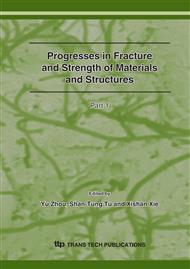[1]
M. Akashi and G. Nakayama: Proc. JSCE-NACE Int. (1997), p.99.
Google Scholar
[2]
K. Nakanishi, Y. Tanaka, K. Yoshida and M. Akashi: Proc. JSCE-NACE Int. (1997), p.691.
Google Scholar
[3]
K. Saito and J. Kuniya: Corro. Sci. Vol. 43, (2001), p.1751.
Google Scholar
[4]
Y-Z. Wang, D. Hardie and R.N. Parkins: Corro. Sci. Vol. 37, (1995), p.1705.
Google Scholar
[5]
H. Kitagawa and Y. Nakasone: J. Soc. Mater. Sci. Jpn. Vol. 33, (1983), p.14.
Google Scholar
[6]
M. Kamaya and T. Kitamura: Int. J. Fracture Vol. 130, (2003), p.787.
Google Scholar
[7]
H. Kitagawa, T. Fujita and K. Miyazawa: ASTM STP 642, (1978), p.98 Fig. 8 Exponential distribution plots for SCC lifetime Time t (Ms).
Google Scholar
[1]
[0] 0. 5 0. 5 1 1. 5 2 2. 5 3 H (t) 0. 9 0. 7 0. 5 0. 3 0. 1 0. 0 Cumulative probability F (t) SCC lifetime amax = 5. 0 mm af = 1. 13 θ f = 0. 667 Time t (Ms).
Google Scholar
[1]
[0] 0. 5 0. 5 1 1. 5 2 2. 5 3 H (t) 0. 9 0. 7 0. 5 0. 3 0. 1 0. 0 Cumulative probability F (t) SCC lifetime amax = 5. 0 mm af = 1. 13 θ f = 0. 667.
Google Scholar
[1]
[0] 0. 5 0. 5 1 1. 5 2 2. 5 3 H (t) 0. 9 0. 7 0. 5 0. 3 0. 1 0. 0 Cumulative probability F (t) SCC lifetime amax = 5. 0 mm af = 1. 13 θ f = 0. 667 Fig. 5 The variation of crack distribution with time. (a) 24 hr (b) 48 hr (c) 96 hr (d) 520 hr (a) 24 hr (b) 48 hr (c) 96 hr (d) 520 hr Fig. 6 Number of cracks as a function of time.
DOI: 10.7554/elife.01699.009
Google Scholar
500 1000 1500 2000 2500 3000 3500 0 0. 5 1 1. 5 2 2. 5 3.
Google Scholar
0. 5 1 1. 5 2 2. 5.
Google Scholar
500 1000 1500 2000 2500.
Google Scholar
[24]
4896 480 240 720 Time t (Ms) Number of cracks per 100 mm2 t (hr) CBB test result.
Google Scholar
[3]
3000 3500 from exponential distribution The number of cracks.
Google Scholar
500 1000 1500 2000 2500 3000 3500 0 0. 5 1 1. 5 2 2. 5 3.
Google Scholar
0. 5 1 1. 5 2 2. 5.
Google Scholar
500 1000 1500 2000 2500.
Google Scholar
[24]
4896 480 240 720 Time t (Ms) Number of cracks per 100 mm2 t (hr) CBB test result.
Google Scholar
[3]
3000 3500 from exponential distribution The number of cracks from exponential distribution The number of cracks Fig. 7 Maximum crack length as a function of time Maximum crack length 2a (mm).
Google Scholar
0. 5 1 1. 5 2 2. 5.
Google Scholar
[2] [4] [6] 824 4896 480 240 720 Time t (Ms) t (hr).
Google Scholar
[3]
[10] [12] [0] [2] [4] [6] [8] [10] [12] 0 0. 5 1 1. 5 2 2. 5 3 Maximum crack length 2a (mm).
Google Scholar
0. 5 1 1. 5 2 2. 5.
Google Scholar
[2] [4] [6] 824 4896 480 240 720 Time t (Ms) t (hr).
Google Scholar
[3]
[10] [12] [0] [2] [4] [6] [8] [10] [12] 0 0. 5 1 1. 5 2 2. 5 3.
Google Scholar


